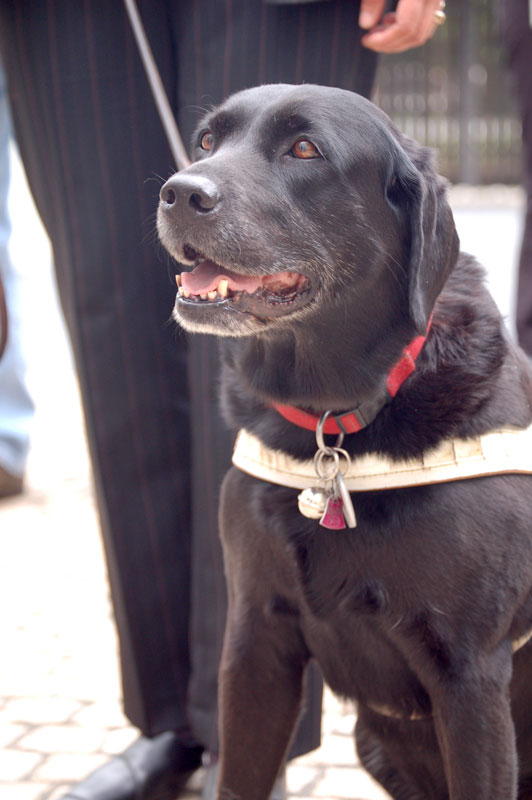
A straightforward answer to this question is a “confident yes”! You can have a guide dog where ever you are in the world as long as you really need it and you’re capable of having it. But “is this type of dog available in the Philippines?”
What is a guide dog anyway? Is it a specific breed? If you’re in the Philippines, Where do you get a guide dog? What do they eat? What’s the difference between a guide dog and a regular breed? Those questions will have answers in the following sections of this article:
- Guide dogs and their characteristics
- Size of the dog, their temperament and their traits
- The three most popular breeds used as guide dogs
- The main issue, about blind people in the Philippines and guide dogs
Guide dogs and their characteristics

According to my installed dictionary, “A guide dog is a dog trained to guide a blind person.” Amusing? Actually, a guide dog is not just capable of helping the blind; it also offers love and affection. Sounds romantic?
In reality, interacting with a guide dog reveals their incredible intelligence and the amazing things they can do. They assist not only the blind but also people with other disabilities, including those who are hearing impaired, stroke survivors, people with seizures, and those with mobility challenges. You’ll be even more impressed when you hear stories of guide dogs saving lives in emergency situations. In short, a smart dog is an ideal candidate to become a guide dog. But what other traits make them so special?
Size of the dog, their temperament and their traits
In any situation, size can make a difference. Imagine walking down the street with your Chihuahua, and suddenly, a much larger dog appears. What do you think your poor Chihuahua’s reaction would be?
Now, let’s reverse the situation. Imagine you own a giant breed, and your guide dog spots a Chihuahua. What will happen? The answer is simple: nothing. Why? Because part of a guide dog’s training is to maintain discipline and focus at all times. Their primary job is to guide their owner, and distractions like other dogs won’t interfere with their task!
In short it’s best to choose a breed that won’t be easily intimidated while working. But the next question is: what breeds are suitable for this type of job?
The three most popular breeds used as guide dogs
Labrador Retriever as guide dog

First on my list is the Labrador Retriever! Why? Because I own one, and I can confidently say this breed is one of the smartest. Many articles about guide dogs and popular books on dogs agree with this. While rankings of the smartest breeds may vary and change yearly, the Labrador consistently ranks high. Its ease of training alone makes it a top choice for guide dogs, solidifying its reputation as a favorite for this important role.
Golden Retriever as guide dog
Next up is the Golden Retriever. There are many similarities between Golden Retrievers and Labrador Retrievers. Due to their size, they can be intimidating to both humans and other dogs, yet they remain effective and are incredibly fun to be around.
German Shepherd as guide dog

The number 3 is the guard dog German Shepherd. Yes it is more famous as a protection dog, but there are people who use it as their guide dog. Again, discipline not size.
Now the main issue, about blind people in the Philippines and guide dogs
Let’s be straightforward: our environment does not allow us to take a guide dog outside our home. Why is that? Here are the factors:
- Congestion on the street
- Unawareness of some people on this kind of practice
- Lack of accessibility features of some public places such as streets or buildings
- Apology but pollution in the city also?
But let’s consider this: if our cities were not polluted, not congested, and the citizens were well-informed, would it then be possible to have guide dogs in the country? Unfortunately, the answer is still no. As far as I know, there are currently no schools for guide dog training in the Philippines. My suggestion is that you can still own any of the breeds I mentioned earlier, but training them to be guide dogs is a different matter altogether.

Do you know if someone visiting from the U.S. can bring their seeing eye dog? The airline said it is no problem for them, but I don’t know how to find out if there are immigration/customs issues of bringing dogs into the country even if only for a couple of weeks.
thanks
Hello. I think this link is exactly what you want.
http://www.dogjaunt.com/posts/readers-report-requirements-for-taking-an-in-cabin-dog-to-the-philippines/
Thanks for the comment.
Hey there, I’m currently working out for my architectural thesis entitled “School for the Deaf and Blind,” do you mind if I ask you some questions.. Please reply to my post or contact me with [email protected]! Thank you and God bless you! 🙂
I have witnessed an nasty incident this weekend at the Robinsons Place in Dumaguete. A blind foreigner with his guide dog was refused entry to the mall because of his dog. What followed was an argument between the blind man and the security guard. The blind man was handcuffed and the police was called.
I was shocked by the insensitivity of those security people. After that I did a Google search on guide dogs in the Philippines. That took me to this site. I have pictures of the incident.
Hello.
Yes it’s very sad news. To me, they should have allowed the dog. Because while it is still an animal, the difference is it is now a trained animal. Anyway, the issue is now a trending topic on PWDs Facebook groups and pages. If the information I got is correct, a representative of the mall is already looking for a person/organization who can give a sensitivity training for their staff. This is a very good move I think. Thanks for the comment.
Hi Joey,
Interesting! I’m a lawyer , veterinärian and the deputy chief of mission for the Philippine Embassy in Norway 🇳🇴
Norway has lots of Training schools
Can we adapt these techniques to the Philippines ?
Hello Mr. Raul Dado and thank you for your comment. I’d like to suggest an organization that could be of great assistance to you – Resources for the Blind Incorporated, located in Cubao, Quezon City, Philippines. You may reach out to them to explore the possibilities they can provide. If they happen to inquire about how you learned about them, feel free to mention this blog. In my opinion, it’s high time for the Philippines to contemplate implementing guide dog assistance for visually impaired Filipinos. When it comes to government agencies, I regret to say that I lack any connections or specific information to offer. Have a nice day!